2014新人教版七年级英语上册全册教案
人教版七年级英语上册教案全套

S: Good morning, I’m Jacky Cheng.
T: Nice to meet you, Jacky.
S: Nice to meet you, too. Bill.
Encourage the students to care what kind of English they can find in the street or in the other ways. Show the students some CDs and ask them if they know what it is. Repeat with the other things. And add some more things such as DVD and KFC. Train the students to care the things happening around them, such as: ID means identification card. OK means all right. Then get them to finish the exercise on the screen. Go on doing the above step to ask them to list more about the abbreviation. (See the powerpoint)
S2:Nice to meet you.too.
Call out several pairs of students to give their performance.Praise their efforts as much as possible.Help the slower students with patience.
人教版英语七上教案7篇

人教版英语七上教案7篇人教版英语七上教案篇11.能听说、认读eye, face , ear, nose, mouth, 这些关于身体部位的单词,并能用英语介绍自己身体的这几个部分2.初步了解表示接触的指示用语,能听懂,并按指令做出相应的动作。
3..激发学生学习兴趣,培养听说习惯和能力。
教学重点:关于头部的单词eye, face , ear, nose, mouth的学习。
教学难点:eye, face 两个单词的元音因素容易发音不到位,教师可鼓励学生张大口型,相互检查。
mouth 一词的尾音发音较难,教师可适当提醒学生,注意口型教学过程:step 1.warm up and revi-sion1.greetings : hello,boys and girls! nice to meet you! sit down please! step2.presentation1. 利用多媒体展示学生感兴趣的动画人物“大耳朵图图”,让学生与图中人物进行口语交流let’s say “hello, tutu.”2.tu tu is so cute.look! this is tutu’s eye.并指着tutu的眼睛介绍。
同时引出新单词eye.a.先让学生倾听录音怎么读单词eye b.再范读教新单词eye(开火车读) c.让学生拼写这个单词e-y-e d.老师借助肢体语言,指着自己的眼睛说:this is my eye e.let’s do.follow me: eye eye 唰唰唰(跟着老师一起做动作).3.用同样的方法依次新授新单词:face、ear、nose、mouth4.powerpoint制作:打开幻灯片后每点击一身体部位就会出现相应的单词。
(注mouth一词的尾音发音较难,适当提醒学生,注意口型。
)5.认读face、ear、eye、nose、mouth的单词卡片和图片。
step3:practice1.let’s do: eye eye 唰唰唰ear ear 呼呼呼nose nose 闻闻闻mouth mouth 巴巴巴face face 拍拍拍2.i say you do.(老师说,学生快速做相应的动作,然后找一位学生出来做出动作。
七年级英语上册人教版全册教案

七年级英语上册人教版全册教案第一章:引言1.1 教学背景1.1.1 分析学生情况:针对七年级学生,英语学习处于基础阶段,需要引导学生逐步适应英语学习。
1.1.2 教材内容:人教版七年级英语上册,以话题为主线,培养学生的基本语言能力。
1.1.3 教学目标:激发学生学习兴趣,建立良好的学习习惯,为后续学习打下基础。
第二章:知识点讲解2.1 语音知识2.1.1 发音规则:介绍长元音、短元音、辅音等发音规则。
2.1.2 语音练习:通过听力练习,让学生辨别单词的正确发音。
2.1.3 语音应用:引导学生运用语音知识正确拼读单词和句子。
2.2 词汇知识2.2.1 单词构成:分析单词的词根、前缀、后缀等构成部分。
2.2.2 词汇练习:通过词汇游戏、练习册等途径,巩固单词记忆。
2.2.3 词汇应用:让学生在实际语境中运用词汇,提高运用能力。
2.3 语法知识2.3.1 基本句型:介绍主谓宾、主谓表等基本句型。
2.3.2 语法规则:讲解时态、语态、比较级、最高级等语法规则。
2.3.3 语法练习:通过填空、改错等形式的练习,巩固语法知识。
第三章:教学内容3.1 课本内容3.1.1 每课主题:根据课本内容,提炼每课的主题。
3.1.2 对话分析:分析对话内容,讲解重点词汇和句型。
3.1.3 课文理解:引导学生理解课文,提高阅读能力。
3.2 拓展内容3.2.1 相关话题:针对课本内容,拓展相关话题。
3.2.2 听力练习:选择合适的听力材料,提高学生听力水平。
3.2.3 口语表达:组织口语交流活动,提高学生口语表达能力。
第四章:教学目标4.1 知识目标4.1.1 掌握基本的语音、词汇和语法知识。
4.1.2 能够听懂、说出一日常用语。
4.1.3 理解课本内容,具备一定的阅读和写作能力。
4.2 能力目标4.2.1 提高学生的听、说、读、写四项基本技能。
4.2.2 培养学生的语言运用能力和团队协作能力。
4.2.3 培养学生的跨文化交际意识。
模式2:2014年秋人教版新目标英语七年级上全册精品教案(66页)
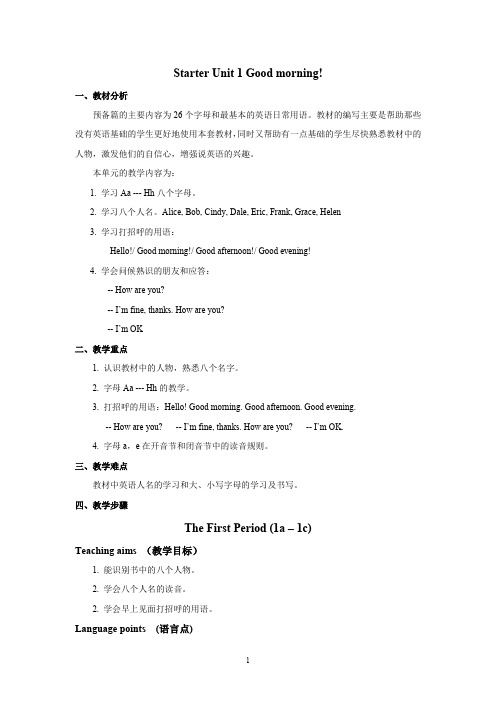
Starter Unit 1 Good morning!一、教材分析预备篇的主要内容为26个字母和最基本的英语日常用语。
教材的编写主要是帮助那些没有英语基础的学生更好地使用本套教材,同时又帮助有一点基础的学生尽快熟悉教材中的人物,激发他们的自信心,增强说英语的兴趣。
本单元的教学内容为:1. 学习Aa --- Hh八个字母。
2. 学习八个人名。
Alice, Bob, Cindy, Dale, Eric, Frank, Grace, Helen3. 学习打招呼的用语:Hello!/ Good morning!/ Good afternoon!/ Good evening!4. 学会问候熟识的朋友和应答:-- How are you?-- I’m fine, thanks. How are you?-- I’m OK二、教学重点1. 认识教材中的人物,熟悉八个名字。
2. 字母Aa --- Hh的教学。
3. 打招呼的用语:Hello! Good morning. Good afternoon. Good evening.-- How are you? -- I’m fine, thanks. How are you? -- I’m OK.4. 字母a,e在开音节和闭音节中的读音规则。
三、教学难点教材中英语人名的学习和大、小写字母的学习及书写。
四、教学步骤The First Period (1a – 1c)Teaching aims (教学目标)1. 能识别书中的八个人物。
2. 学会八个人名的读音。
2. 学会早上见面打招呼的用语。
Language points (语言点)1. 词汇:1) 名词n.:morning, Alice, Bob, Cindy, Dale, Eric, Frank, Grace, Helen2)形容词adj. :good3) 感叹词interj. :hi, hello2. 句型:Hello! Good morning!Difficulties (教学难点):1. 八个英语名字的正确发音;2. 字母A, C, G, H的正确发音Teaching steps (教学步骤)1. Warming-up (课堂热身)(1) Teacher puts a name card with an English name above and a Chinese name below on the big desk, then points to the name card and have an introduction.T: This is my name card. I have a Chinese name ... And I have an English name ... You can call me...(2) Greet the whole class and help them to say,Hello, ... ! Good morning, ...! (学生还没有英文名,就用中文名打招呼)2. Presentation (呈现新知识)Teacher shows the photos of the eight persons by playing PPT and helps students to learn to pronounce the names. Teacher says,Here are some new students. Let’s look at them and learn their names.3. Work on 1a (完成1a)(1) Teacher shows the picture on Page 1 by playing PPT. (此步骤不出现问候语)(2) Teacher points to the persons and students say their names.(3) Teacher says one of the names and students repeat it, and then write it below Boy’s nam e or Girl’s name in the book.(4) Check their answers.E.g. T: Li Lei.S: Yes.(示意学生起立回答问题)T: Is Frank a boy’s name or a girl’s name?S: A boy’s name.T: Right. You can get the English name, Frank. Sit down, please.S: Thank you.4. Presentation (呈现新知识)Teacher shows a picture with Bob, let students guess what Bob wants to say to us. The answer maybe: Hello, Helen! or Good morning, Helen!5. Work on 1b (完成1b)(1) Play the recording for the first time, Students only listen.(2) Play the recording for the second time. Students listen and repeat.(3) Play the recording for the third time. Students look, listen and repeat.Teacher: Now please open your books and turn to Page 1. You can look at the conversation in your book. Le t’s listen and repeat.6. Work on 1c (完成1c)(1)Students practice reading the conversations in the picture in pairs. Teacher moves around the classroom when students are practicing. Give them some help if they need.(2)Teacher greets the students who has just get their English names. The other students listen, watch and learn.(3)Students practice greeting each other. They can use their Chinese names if they wish. Encourage them to use their English names if they can.(4)T: Now I’ll ask some pairs to practice your own conversations. (学生小组起立进行对话表演。
七年级上册英语全册教案(人教版)

人教版七年级英语上册全册教案******学校教师备课笔记学校教师备课笔记Revise some school things byasking questions. e.g.: What ’s this? Is this a …? How do you spell it?etc.Learn the new words in, on, under, behind … by helping the teacher find the lost things. e.g.: T: Where ’s my English book? S1: It ’s here. / I think it ’s …T: Oh, it ’s on the desk. … T: Where ’re my color pencils? S2: … Teach the new word “where ” and the use of “they ”. Consolidate the prepositions by looking at thescreen and answer thequestions: Where ’s … ?Where ’re …?Hide and look for thingsShow the students a picture of a room, tell them this is a bedroom, let the students list the things in it first. Then show them the whole picture, teach the new words, ask where the things are, let the students answer, using the prepositions.Repeat with a sitting room and a study, teach the new words and practice in the same way.Section A, 1a: Match the words with the things in the picture. Students do it individually first, then check the answers. Section A, 1c: Make up dialogues in pairs, using the things in the picture.Chatting. Chat with the students about the things around the room by showing them pictures. Ask the students to spell the new words. Section A, 2a. Revise what the things are. Play the tape for students and let them number them. Section A, 2b. Play the tape again, students number the things [1-6] in the picture. Imitate the dialoguesSection A, 2c. Look at the picture in 2b again. Students use general questions to ask and answer about the things in it.Ask some students to report their answer like this: In Picture 1, the pencil case is …In Picture 2, the pencil case is…; In Picture 1, the books are …In Picture 2, the books are …Present short dialogues, using pictures or objects to help. Dialogue 1: A: Where’s my bag? B: I don’t know. Is it on the sofa? A: No, it isn’t. Dialogue 2: A: Where’re my books? B: I don’t know. Are they on the bed? A: Yes, they are. Teach “don’t =do not”, “know”. Check the homework in Period One. Make reports to share the information they got from the friends or teachers, and give their simply assessment.Let the students makesimilar dialogues according to the pictures in Section A, 3a&3c. Put the dialogue in the right order.( Section A, 3a.) Listen and imitate the dialogues in Section A, 1b.answer make similar dialogues according to the pictures in Section A, 3a&3c.Ask some pairs to act out the dialogues in Section A, 2a & 2b. Show the students a picture of a room. Let the students say likethis: The ID card is on the table. The books are on the chair. Let some able students list some new words. Practice reading them. Match the new words with the things in thepicture. (Section B, 2a.) Pairwork. Talk about the picture.( Section B, 1b&1c.)Play the tape twice for students to listen and circle the things Tommy wants from his room. Check the answers. ( Section B, 2a. )Listen again.Show a picture of a roomwith a few things in it, give the students a short note about the things around the room to read, let the students try to find out thedifferences between the reading material and the picture. Circle the mistakesin the reading material. Make an orally report by looking at the picture again. The students read the note silently and draw the missing things in the picture. ( Section B, 3a.) (为了节省时间,教师可以让学生在图中标出数字来替代画图。
模式3:2014年秋人教版新目标英语七年级上册英语表格教案(79页)
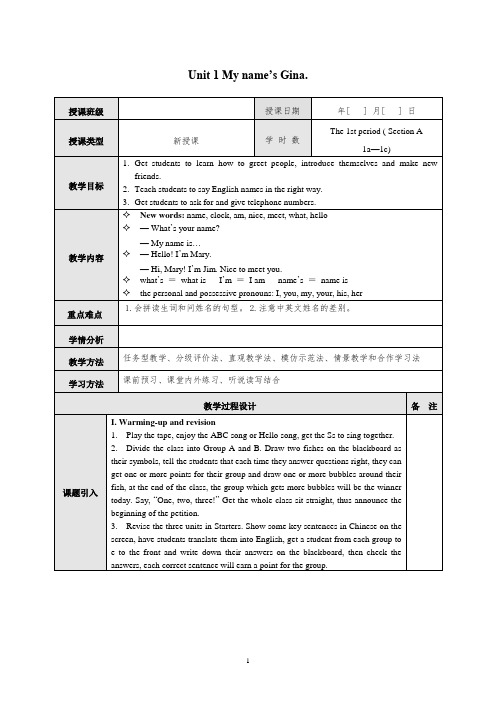
Unit 1 My name’s Gina.授课班级授课日期年[ ] 月[ ] 日授课类型新授课学时数The 1st period ( Section A1a—1c)教学目标1.Get students to learn how to greet people, introduce themselves and make newfriends.2.Teach students to say English names in the right way.3.Get students to ask for and give telephone numbers.教学内容✧New words: name, clock, am, nice, meet, what, hello✧— What’s your name?— My name is…✧— Hello! I’m Mary.— Hi, Mary! I’m Jim. Nice to meet you.✧what’s =what is I’m =I am name’s =name is✧the personal and possessive pronouns: I, you, my, your, his, her重点难点1.会拼读生词和问姓名的句型。
2.注意中英文姓名的差别。
学情分析教学方法任务型教学、分级评价法、直观教学法、模仿示范法、情景教学和合作学习法学习方法课前预习、课堂内外练习、听说读写结合教学过程设计备注课题引入I. Warming-up and revision1. Play the tape, enjoy the ABC song or Hello song, get the Ss to sing together.2. Divide the class into Group A and B. Draw two fishes on the blackboard as their symbols, tell the students that each time they answer questions right, they can get one or more points for their group and draw one or more bubbles around their fish, at the end of the class, the group which gets more bubbles will be the winner today. Say, “One, two, three!” Get the whole class sit straight, thus announce the beginning of the petition.3. Revise the three units in Starters. Show some key sentences in Chinese on the screen, have students translate them into English, get a student from each group to e to the front and write down their answers on the blackboard, then check the answers, each correct sentence will earn a point for the group.教学步骤及主要内容II. Presentation1.Teacher says: , “Hello! My name is Lily. What’s your name?” Get thestudents to answer, “My name is …” Then teacher says, “It’s a good / nice name. I like your name.”2.On the screen show a lovely mouse saying “My name’s Gina.”Underline“My name’s”, tell the students it means “My name is/ I am/ I’m”.3.Show the question “What’s your name?”Underline “What’s”, tell thestudents that it means “What is”.III. Listening drills (1)1.Do Section A, 1b, listen and number the conversations (1-3).2.Show the picture on page 1 on the screen with no words on it. Get student tolisten to the tape and try to repeat the sentences in the conversations, each correct sentence will earn a point for the group.课堂练习IV. Pair-work.1.Get the students listen to the conversations again and repeat after the tape,then work in groups, practice the conversations with the partners.2.Have some students e to the front and show their own conversation, thenmake a ment on it (praise the students first) and give 2 to 4 points to their group.3.Do Section A, 1a. First, have the students work in groups, write down asmany words as possible on their students’ books in only 2 minutes; then get a student from each group to write down their words on the blackboard at the same time, the one who writes more can get more points.V. Listening drills (2)1.Do Section A, 2a. Listen to four conversations and number the pictures (1-4).2.Do Section A, 2b. Listen again, circle the names according to the tape.Listen for the last time, then fill in the blanks.小结与作业课堂小结本课作业1.Listen and read after the tape for thirty minutes.2.Recite the first conversation of Section A, 2c.3.Write down the Chinese meaning of the new words and key sentences, thentranslate them into English.本课教学后记(课堂设计理念,实际教学效果及改进设想)Unit 1 My name’s Gina.授课班级授课日期年[ ] 月[ ] 日授课类型对话课学时数The 2nd period ( Section A 1c -- 4)教学目标1.Get the students to learn how to greet people.2.Get the students to learn to get other people’s basic information like names from the conversations.教学内容✧New words: his, and, her, question, answer, look ✧-- What’s your/his/her name?-- My/His/Her name is ……重点难点1、了解英语与汉语中姓与名的位置不同,准确掌握英语的姓与名的表达;2、听懂并能说出电话号码,培养学生的英语意识。
新版人教版七年级上册英语教案完整版

新版人教版七年级上册英语教案集团标准化办公室:[VV986T-J682P28-JP266L8-68PNN]U n i t1M y n a m e’s G i n a.Newwords:name,clock,am,nice,meet,what,hello—What’syourname?—Mynameis…—Hello!I’mMary.—Hi,Mary!I’mJim.Nicetomeetyou.what’s=whatisI’m=Iamname’s=nameisthepersonalandpossessivepronouns:I,you,my,your,his,herUnit1Myname’sGina.Newwords:his,and,her,question,answer,look--What’syour/his/hername?--My/His/Hernameis……1、了解英语与汉语中姓与名的位置不同,准确掌握英语的姓与名的表Unit1Myname’sGina.Newwords:zero,one,two,three,four,five,six,seven,eight,n ine--What’syourphonenumber?--It’s…1、了解英语与汉语中姓与名的位置不同,准确掌握英语的姓与名的表Unit1Myname’sGina.What’shertelephonenumberWhat’sherfamilynameWhat’sherfirstname—MynameisTina.Nicetomeetyou.—I’mMary.Nicetomeetyoutoo.1、了解英语与汉语中姓与名的位置不同,准确掌握英语的姓与名的表Unit2Thisismysister.Newwords:mother,father,parents,brothers,grandmother,grandfa ther,friendandsister.Thisismybrother.Thesearemytwobrothers.Andthat’smysister.Unit2Thisismysister.Newwords:aunt,uncle,cousin,thechildofone’suncleoraunt堂或表兄弟姊妹,表亲()nephew(thesonofone’sbrotherorsister)侄儿niece(thedaughterofone’sbrotherorsister)侄女,甥女--IsthisJim?--No,heisn’t.he’sDave.--Isthisyoursister?No,itisn’t.--Isthatyourbrother?Yes,itis.Herewhenyoutalkaboutthepicture,youc anuse“it”torefertheperson.Payattentionto“he”or“she”.Unit2Thisismysister.Unit3Isthisyourpencil?Newwords:pen,pencil,book,eraser,ruler,pencilcasebackpack,pe ncilsharpener,dictionary.--Isthisyourruler?--No,itisn’t.it’sherruler.--Isthatyourbackpack?--No,itisn’t.it’shisbackpack.Unit3Isthisyourpencil? Newwords:pairwork--What’sthisinEnglish--It’sapen.--Howdoyouspellit?--P-E-N.--What’sthisinEnglish--It’sapen.--Howdoyouspellit?--P-E-N.Unit3Isthisyourpencil?Newwords:baseball,computer,game,watch,IDcard,notebook. What’sthisinEnglishIt’sawatch.Howdoyouspellit?W-A-T-C-H. CallAllenat495-8536.Isthatyourcomputergameinthelostandfoundcase?PleasecallMar y.Asetofkeys.Unit3Isthisyourpencil?Unit4Where’smyschoolbag?Newwords:table,bed,dresser,bookcase,sofa,chair,backpack,b ooks,keys,baseball,drawer,plant,on,in,under.—Where’sthebackpack—It’sunderthetable.—Wherearethekeys?—They’reinthedrawer.where’s=whereisIt’s=ItisThey’re=Theyare theprepositions:on,in,under---where’sthebag?---Idon’tknow.Isitonthedesk?---Pleasetakethesethingstoyoursister.---Canyoubringsomethingstoschool?Unit4Where’smyschoolbag?Unit4Where’smyschoolbag? Newwords:videotape,alarmclock,mathbook,hat Sentences:Themathbookisonthedresser.Unit4Where’smyschoolbag Newwords:take,bring,needSentences:Pleasetakethesethingstoyoursister. Canyoubringsomethingstoschool?Ineedmyhat,…Unit5Doyouhaveasoccerball Newwords:tennisracket,ping-pongball,soccerball,basketball,TV,have.—Doyouhaveaping-pongball?—Yes,Ido.—Doyouhaveaping-pongbat?—No,Idon’t.--Doeshehaveatennisracket?--Yes,hedoes./No,he doesn’t.don’t=donot doesn’t=doesnot—Doyouhaveaping-pongball?—Yes,Ido.—Doyouhaveaping-pongbat?—No,Idon’t.--Doeshehaveatennisracket?--Yes,hedoes./No,he doesn’t.don’t=donot doesn’t=doesnotUnit5Doyouhaveasoccerball Newwords:his,and,her,question,answer,look--What’syour/his/hername?--My/His/Hernameis……Newwords:his,and,her,question,answer,look --What’syour/his/hername--My/His/Hernameis……Unit5DoyouhaveasoccerballNewwords:interesting,fun,relaxing,boring,difficult --Let’splaysoccer.--Idon’t haveasoccer.---Well,let’splayvolleyball.---Thatsoundsgood.--Let’splaysoccer.--Idon’t haveasoccer.---Well,let’splayvolleyball. ---Thatsoundsgood.Unit5DoyouhaveasoccerballUnit6DoyoulikebananasUnit6DoyoulikebananasUnit6DoyoulikebananasUnit6DoyoulikebananasUnit7HowmucharethesesocksNewwords:socks,T-shirt,pants,shoes,shorts,sweater,skirt,bag,dollars,black,wh ite,green,red,blue,big,small,short,ling,numbers10-31—HowmuchistheblueT-shirt?It’s10dollars.OK,I’lltakeit.—Thankyou..—You’rewelcome.—Howmucharethesesweaters?They’reeightdollars.Whatcolordoyouwant?Iwantgreen.Hereyouare.I’lltakeit/them.—HowmuchistheblueT-shirt?It’s10dollars.OK,I’lltakeit.—Thankyou..—You’rewelcome.—Howmucharethesesweaters?They’reeightdollars. Whatcolordoyouwant? Iwantgreen. Hereyouare.I’lltakeit/them.Unit7Howmucharethesesocks Newwords:red,green,black,white,blue,yellow--Whatcolordoyouwant?Iwantblue.Hereyouare.Thankyou!I’lltakeit.……。
人教版七年级英语上册全册教案
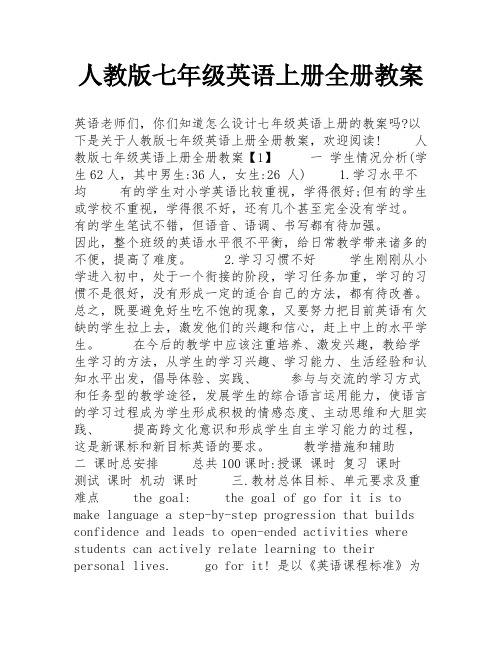
人教版七年级英语上册全册教案英语老师们,你们知道怎么设计七年级英语上册的教案吗?以下是关于人教版七年级英语上册全册教案,欢迎阅读! 人教版七年级英语上册全册教案【1】一学生情况分析(学生62人,其中男生:36人,女生:26 人) 1.学习水平不均有的学生对小学英语比较重视,学得很好;但有的学生或学校不重视,学得很不好,还有几个甚至完全没有学过。
有的学生笔试不错,但语音、语调、书写都有待加强。
因此,整个班级的英语水平很不平衡,给日常教学带来诸多的不便,提高了难度。
2.学习习惯不好学生刚刚从小学进入初中,处于一个衔接的阶段,学习任务加重,学习的习惯不是很好,没有形成一定的适合自己的方法,都有待改善。
总之,既要避免好生吃不饱的现象,又要努力把目前英语有欠缺的学生拉上去,激发他们的兴趣和信心,赶上中上的水平学生。
在今后的教学中应该注重培养、激发兴趣,教给学生学习的方法,从学生的学习兴趣、学习能力、生活经验和认知水平出发,倡导体验、实践、参与与交流的学习方式和任务型的教学途径,发展学生的综合语言运用能力,使语言的学习过程成为学生形成积极的情感态度、主动思维和大胆实践、提高跨文化意识和形成学生自主学习能力的过程,这是新课标和新目标英语的要求。
教学措施和辅助二课时总安排总共100课时:授课课时复习课时测试课时机动课时三.教材总体目标、单元要求及重难点the goal: the goal of go for it is to make language a step-by-step progression that builds confidence and leads to open-ended activities where students can actively relate learning to their personal lives. go for it! 是以《英语课程标准》为依据,以学生的英语语言综合运用能力为目标。
人教版七年级上册全册英语教案
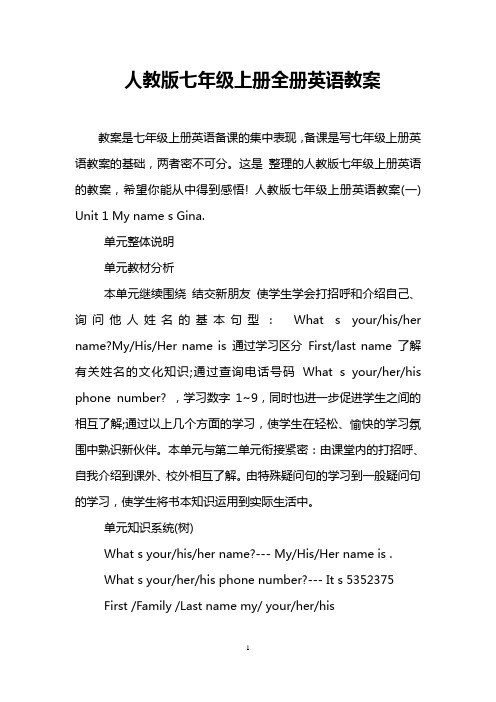
人教版七年级上册全册英语教案教案是七年级上册英语备课的集中表现,备课是写七年级上册英语教案的基础,两者密不可分。
这是整理的人教版七年级上册英语的教案,希望你能从中得到感悟! 人教版七年级上册英语教案(一) Unit 1 My name s Gina.单元整体说明单元教材分析本单元继续围绕结交新朋友使学生学会打招呼和介绍自己、询问他人姓名的基本句型:What s your/his/her name?My/His/Her name is 通过学习区分First/last name 了解有关姓名的文化知识;通过查询电话号码What s your/her/his phone number? ,学习数字1~9,同时也进一步促进学生之间的相互了解;通过以上几个方面的学习,使学生在轻松、愉快的学习氛围中熟识新伙伴。
本单元与第二单元衔接紧密:由课堂内的打招呼、自我介绍到课外、校外相互了解。
由特殊疑问句的学习到一般疑问句的学习,使学生将书本知识运用到实际生活中。
单元知识系统(树)What s your/his/her name?--- My/His/Her name is .What s your/her/his phone number?--- It s 5352375First /Family /Last name my/ your/her/his单元总体目标运用Practicing, Listening for specific information的学习策略,引导学生学会打招呼和介绍自己、询问他人姓名、查询电话号码的基本句型;了解有关姓名的文化知识;学习特殊疑问句及my/ your/her/his等物主代词的用法。
单元教学重难点一览1.复习词汇clock ball bag cap key book ruler hello hi name nice meet2.词汇your/her/his First/Last zero one two three four five six seven eight nine phone number family3.句型What s your/his/her name?---My/His/Her name is .What s your/her/his phone number?---It s 5352375语法焦点在于my /your/her/ his等物主代词本单元的主题是熟识新伙伴,同时引导学生采用Practicing, Listening for specific information和Role playing的学习策略,学习一些新词汇,掌握一些重点句型,在小组合作学习的过程中,进一步促进学生之间的相互了解。
新人教版七年级英语上册教案全集
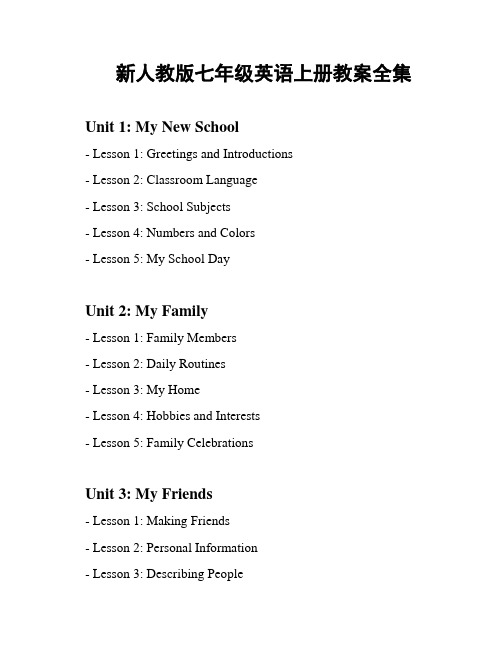
新人教版七年级英语上册教案全集Unit 1: My New School- Lesson 1: Greetings and Introductions- Lesson 2: Classroom Language- Lesson 3: School Subjects- Lesson 4: Numbers and Colors- Lesson 5: My School DayUnit 2: My Family- Lesson 1: Family Members- Lesson 2: Daily Routines- Lesson 3: My Home- Lesson 4: Hobbies and Interests- Lesson 5: Family CelebrationsUnit 3: My Friends- Lesson 1: Making Friends- Lesson 2: Personal Information- Lesson 3: Describing People- Lesson 4: Hobbies and Activities - Lesson 5: Inviting and AcceptingUnit 4: My Day- Lesson 1: Daily Routines- Lesson 2: Time and Activities- Lesson 3: Weather and Seasons - Lesson 4: School Timetable- Lesson 5: Daily HabitsUnit 5: My Weekends- Lesson 1: Weekend Activities- Lesson 2: Places in the City- Lesson 3: Giving Directions- Lesson 4: Leisure Activities- Lesson 5: Planning the WeekendUnit 6: My Favorite Things - Lesson 1: Likes and Dislikes- Lesson 2: Sports and Hobbies- Lesson 3: Food and Drinks- Lesson 4: Clothes and Colors- Lesson 5: Shopping for FavoritesUnit 7: Healthy Habits- Lesson 1: Healthy Living- Lesson 2: Healthy Eating- Lesson 3: Sports and Exercise- Lesson 4: Daily Routines- Lesson 5: Staying Fit and ActiveUnit 8: Festivals and Traditions - Lesson 1: Festivals and Celebrations - Lesson 2: Traditional Customs- Lesson 3: Holiday Activities- Lesson 4: Traditional Foods- Lesson 5: Sharing TraditionsUnit 9: My Country- Lesson 1: National Symbols- Lesson 2: Geography and Landmarks- Lesson 3: Cultural Diversity- Lesson 4: Traditional Arts- Lesson 5: Exploring My CountryUnit 10: Global Citizenship- Lesson 1: Global Issues- Lesson 2: Environmental Awareness- Lesson 3: Social Responsibility- Lesson 4: Volunteer Work- Lesson 5: Making a Difference以上是《新人教版七年级英语上册》的教案全集。
七年级英语上册人教版全册教案
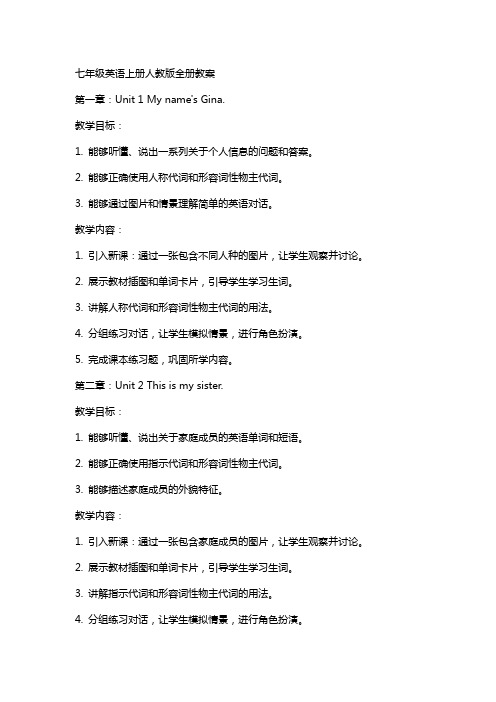
七年级英语上册人教版全册教案第一章:Unit 1 My name's Gina.教学目标:1. 能够听懂、说出一系列关于个人信息的问题和答案。
2. 能够正确使用人称代词和形容词性物主代词。
3. 能够通过图片和情景理解简单的英语对话。
教学内容:1. 引入新课:通过一张包含不同人种的图片,让学生观察并讨论。
2. 展示教材插图和单词卡片,引导学生学习生词。
3. 讲解人称代词和形容词性物主代词的用法。
4. 分组练习对话,让学生模拟情景,进行角色扮演。
5. 完成课本练习题,巩固所学内容。
第二章:Unit 2 This is my sister.教学目标:1. 能够听懂、说出关于家庭成员的英语单词和短语。
2. 能够正确使用指示代词和形容词性物主代词。
3. 能够描述家庭成员的外貌特征。
教学内容:1. 引入新课:通过一张包含家庭成员的图片,让学生观察并讨论。
2. 展示教材插图和单词卡片,引导学生学习生词。
3. 讲解指示代词和形容词性物主代词的用法。
4. 分组练习对话,让学生模拟情景,进行角色扮演。
第三章:Unit 3 Please open the window.教学目标:1. 能够听懂、说出关于日常生活中的祈使句。
2. 能够正确使用动词短语。
3. 能够根据情景进行简单的交际。
教学内容:1. 引入新课:通过一个日常生活中的场景,让学生观察并讨论。
2. 展示教材插图和单词卡片,引导学生学习生词。
3. 讲解祈使句的用法和动词短语的构成。
4. 分组练习对话,让学生模拟情景,进行角色扮演。
5. 完成课本练习题,巩固所学内容。
第四章:Unit 4 Is this your schoolbag?教学目标:1. 能够听懂、说出关于物品所有格的英语单词和短语。
2. 能够正确使用一般疑问句和回答。
3. 能够描述物品的特征。
教学内容:1. 引入新课:通过一张包含不同物品的图片,让学生观察并讨论。
2. 展示教材插图和单词卡片,引导学生学习生词。
新人教版七年级英语上册教案设计(全册)
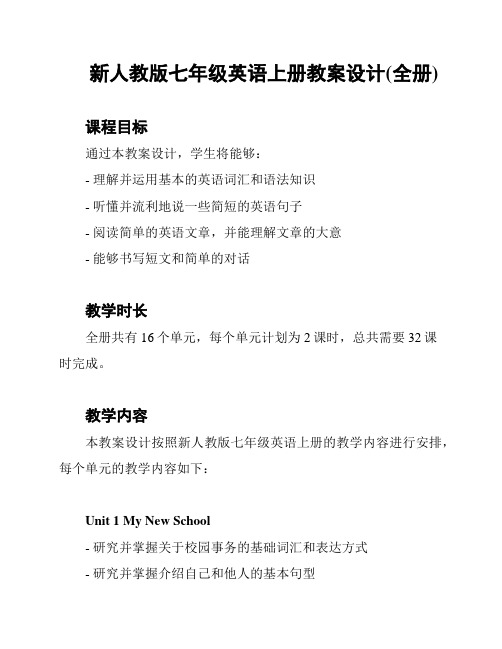
新人教版七年级英语上册教案设计(全册)课程目标通过本教案设计,学生将能够:- 理解并运用基本的英语词汇和语法知识- 听懂并流利地说一些简短的英语句子- 阅读简单的英语文章,并能理解文章的大意- 能够书写短文和简单的对话教学时长全册共有16个单元,每个单元计划为2课时,总共需要32课时完成。
教学内容本教案设计按照新人教版七年级英语上册的教学内容进行安排,每个单元的教学内容如下:Unit 1 My New School- 研究并掌握关于校园事务的基础词汇和表达方式- 研究并掌握介绍自己和他人的基本句型- 进行听说读写综合的语言训练Unit 2 My Daily Routine- 研究并掌握描述日常活动的基础词汇和句型- 进行情景对话练,提高口语表达能力- 阅读并理解简短的日常活动文章... (以下省略,总共16个单元)教学活动安排在每个单元的教学中,教师可以采用以下教学活动进行教学:1. 课前导入:利用图片或实物引起学生兴趣,激活相关背景知识2. 听说训练:通过听力材料和口语操练,提高学生的听说能力3. 读写训练:通过阅读和写作练,提高学生的阅读理解和写作能力4. 评价与反馈:给予学生适当的评价和反馈,鼓励他们的研究动力教学评价在每个单元结束后,可采用以下方式对学生进行评价:1. 课堂练:通过课堂练,检测学生对本单元知识的掌握情况2. 作业批改:对学生的书面作业进行批改,并给予指导和建议3. 口语表达:通过口语交流活动,评估学生的口语表达能力4. 综合测试:每个单元结束时进行综合测试,检测学生对整个单元内容的掌握情况以上是对新人教版七年级英语上册教案设计的概要介绍,详细的教案设计可根据教材内容进行编写。
教师可根据学生的实际情况和课程进度进行适当调整和修改,以达到最佳的教学效果。
人教版初中七年级上册英语教案(完整版)
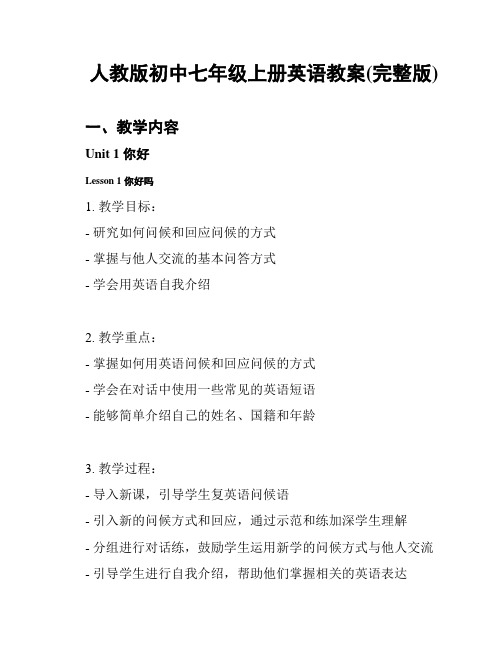
人教版初中七年级上册英语教案(完整版)一、教学内容Unit 1 你好Lesson 1 你好吗1. 教学目标:- 研究如何问候和回应问候的方式- 掌握与他人交流的基本问答方式- 学会用英语自我介绍2. 教学重点:- 掌握如何用英语问候和回应问候的方式- 学会在对话中使用一些常见的英语短语- 能够简单介绍自己的姓名、国籍和年龄3. 教学过程:- 导入新课,引导学生复英语问候语- 引入新的问候方式和回应,通过示范和练加深学生理解- 分组进行对话练,鼓励学生运用新学的问候方式与他人交流- 引导学生进行自我介绍,帮助他们掌握相关的英语表达4. 板书设计:- 问候语- Hello!- Hi!- How are you?- I'm fine, thank you.- 自我介绍- My name is [name].- I am from [country].- I am [age] years old.5. 作业要求:- 完成课堂练册上的相关练- 准备下节课的自我介绍Lesson 2 你是谁(以下内容略去不写)Unit 2 我的家(以下内容略去不写)二、教学目标在初中七年级上册英语教学中,我们旨在通过教授Unit 1和Unit 2的内容,帮助学生学会基本的英语问候和自我介绍方式,以及描述家庭成员和家庭的基本词汇。
通过各种实践活动和练,学生将能够在日常生活中简单地应用这些英语表达方式。
三、教学方法- 情景教学法:通过创设真实情景,引导学生使用所学知识进行对话练。
- 归纳法:通过提供示范和练,让学生总结语言规律和表达方式。
四、教学资源- 人教版初中英语教材《七年级上册》- 课件和多媒体设备- 课堂练册五、教学评估通过课堂练、对话练和个人介绍的方式,对学生对所学内容的掌握程度进行评估。
六、教学反馈及时反馈学生的研究情况,鼓励他们在研究过程中的积极表现,并针对学生的不足之处提出改进建议。
七、教学改进根据学生的研究情况和反馈意见,不断优化课堂教学过程,提高学生的研究效果。
新人教版七年级英语上册全册教案
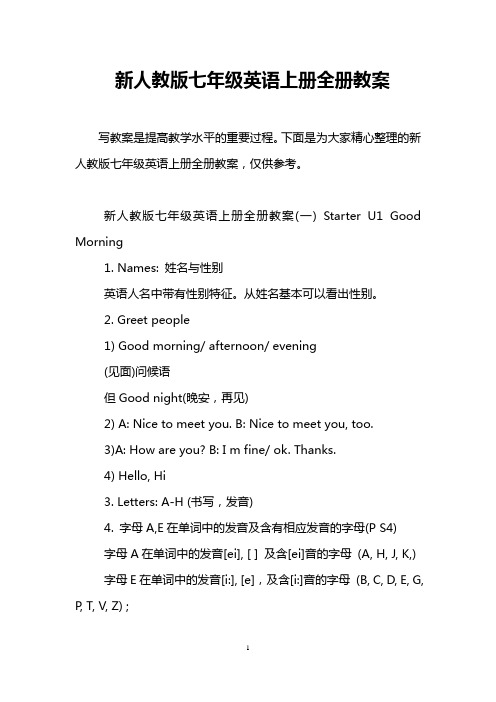
新人教版七年级英语上册全册教案写教案是提高教学水平的重要过程。
下面是为大家精心整理的新人教版七年级英语上册全册教案,仅供参考。
新人教版七年级英语上册全册教案(一) Starter U1 Good Morning1. Names: 姓名与性别英语人名中带有性别特征。
从姓名基本可以看出性别。
2. Greet people1) Good morning/ afternoon/ evening(见面)问候语但Good night(晚安,再见)2) A: Nice to meet you. B: Nice to meet you, too.3)A: How are you? B: I m fine/ ok. Thanks.4) Hello, Hi3. Letters: A-H (书写,发音)4. 字母A,E在单词中的发音及含有相应发音的字母(P S4)字母A在单词中的发音[ei], [ ] 及含[ei]音的字母(A, H, J, K,)字母E在单词中的发音[i:], [e],及含[i:]音的字母(B, C, D, E, G, P, T, V, Z) ;含[e]音的字母(F, L,M, N, S,X,Z)新人教版七年级英语上册全册教案(二) Starter U2 What s this in English?1.介绍身边事物及中英文拼写Eg 1) A: What s this in English?B: It s a schoolbag.A: Spell it, please. (How to spell it?)B:s-c-h-o-o-l-b-a-gEg 2) A: What s this in English?B: It s an orange.A: Spell it, please. (How to spell it?)B:o-r-a-n-g-eEg 3) A: What s that in English?B: It s a jacket.A: Spell it, please. (How to spell it?)B: J-A-C-K-E-T.补充:1) in表示用(语言) 。
新人教版七年级英语上册全册教案

2014年新人教版七年级英语上册全册教案Unit 1 My name is Gina.1.Topic话题:Making new friends2.功能目标:1)Introduce yourself使学生学会用英语介绍自己。
2)Greet people使学生学会用英语和别人打招呼。
3)Ask for and give telephone numbers 询问和给出电话号码3.文化目标:1)让学生初步体会用英语和别人交流的感受,培养学生学习英语的兴趣。
2)通过对英文名字的介绍,对比中西方表达名字的不同,了解中西方文化的差异。
3)通过对西方一些成功人士英文名字的介绍,使学生了解成功是由不懈的努力和艰苦的奋斗得来的。
4)通过介绍英文名字的由来,使学生产生对西方文化的好奇及兴趣。
4.认知目标:1)词汇:clock, hello, hi, and, question, answer, look, first name, last name2) 语法项目:一般现在时be的用法以特殊疑问词what开头的问句形容词性物主代词my, your, his, herWhat’s=What is I’m=I am My name’s=My name is3) Language goals语言目标:What’s your name?My name is Gina.I’m Gina. Nice to meet you.What’s your telephone number? It’s….Period oneI.教材分析:这是课本的第一部分,题目是My mane is Gina. 有很多学生第一次学习接触英语,为了调动他们的积极性,不产畏难情绪,尽量简单的处理教材。
Language topic: What’s your name?My name is Gina.Language strategies: Talk about the namesMain vocabulary: name is, meet, his, first name, last name, answer, boy , girl.II.语言结构: present tense to be, what questions, Possessive adj. my, your, his, her. 。
七年级英语上册人教版全册教案

七年级英语上册人教版全册教案一、第一单元:My name's Gina,my name's L cy1. 教学目标:了解并掌握自我介绍的常用句型,如“My name's”和“I'm from”。
能够正确书写自己的姓名和来自的地方。
学会使用问候语与人打招呼。
2. 教学内容:单词:name, I'm, from, where, am, class, grade, school, in, my 句型:1. My name's 2. I'm from对话:1. A: My name's Gina. B: Nice to meet you, Gina.2. A: I'm from Beijing. B: Oh, really? I'm from Shangh.3. 教学步骤:1) 热身活动:让学生自由交谈,互相问候。
2) 引入新课:展示图片,引导学生说出自己和他的家乡。
3) 讲解单词和句型:讲解单词和句型的用法。
4) 练习对话:让学生分角色扮演,进行对话练习。
5) 总结:检查学生的学习效果,进行反馈。
二、第二单元:What's your name?1. 教学目标:掌握询问别人姓名的常用句型“What's your name?”和回答“My name's”。
学会介绍自己的年龄和年级。
2. 教学内容:单词:hello, nice, to, you, what, name, is, my, how, old, are, you, in, grade句型:1. What's your name? 2. My name's 3. How old are you? 4. I'm in grade.对话:1. A: Hello, nice to meet you. B: Hello, nice to meet you, too.2. A: What's your name? B: My name's Tom.3. 教学步骤:1) 热身活动:让学生自由交谈,互相问候。
人教版初中英语七年级上册教案【】

人教版初中英语七年级上册教案【】人教版初中英语七年级上册教案【完整版】教案一:Unit 1 My School Day课时目标通过本课的研究,学生将能够:- 熟悉并正确运用词汇:morning, afternoon, class, library, schoolbag, pencil case;- 学会表达日常活动并能使用句子:I haveEnglish/Math/Chinese/Art class in the morning/afternoon;- 规范使用句型:What do you have in the morning/afternoon? I have...- 了解不同国家的学校日常活动;- 培养学生自主研究和合作研究的能力。
教学重难点- 重点:掌握词汇和句型的正确运用,以及学校日常活动的表达方式;- 难点:个别学生可能难以理解不同国家的学校日常活动。
教学准备课件、图片、黑板、笔记本、学生课本等。
教学过程1. 导入新课:- 利用图片和问题引入话题,激发学生的兴趣。
- 向学生展示不同国家的学校图片,询问学生对这些学校的日常活动有什么了解。
2. 研究新词汇和句型:- 通过图片和示范,教授新词汇和句型。
- 学生跟读并模仿教师正确运用句型进行练。
3. 合作研究:- 将学生分成小组,让他们利用所学的句型进行交流和讨论。
- 教师巡视并指导学生在小组中开展合作研究。
4. 归纳总结:- 教师与学生一起归纳总结本课所学的内容,以加深记忆。
- 学生用自己的话表达今天的收获。
5. 作业布置:- 布置家庭作业,要求学生用英语描述自己在早上和下午的学校日常活动。
教学反思本节课通过情境导入和多种教学方法的使用,激发了学生学习英语的兴趣。
合作学习环节有效地培养了学生的社交能力和语言表达能力。
通过图片和示范引导学生学习新词汇和句型,使学生能够运用所学知识进行交流和描述,达到了教学目标。
人教版七年级(2014版)英语上册全册说课稿
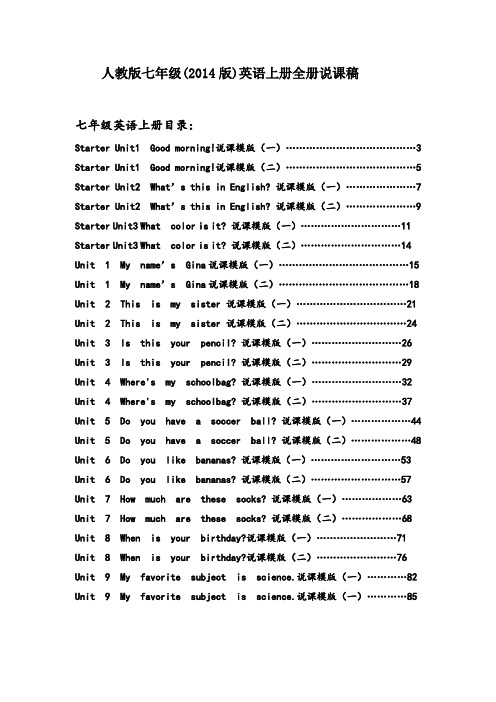
人教版七年级(2014版)英语上册全册说课稿七年级英语上册目录:Starter Unit1Good morning!说课模版(一) (3)Starter Unit1Good morning!说课模版(二) (5)Starter Unit2 What’s this in English?说课模版(一) (7)Starter Unit2 What’s this in English?说课模版(二) (9)Starter Unit3What color is it? 说课模版(一) (11)Starter Unit3What color is it? 说课模版(二) (14)Unit1My name’s Gina说课模版(一) (15)Unit1My name’s Gina说课模版(二) (18)Unit2This is my sister 说课模版(一) (21)Unit2This is my sister 说课模版(二) (24)Unit3Is this your pencil? 说课模版(一) (26)Unit3Is this your pencil? 说课模版(二) (29)Unit4Where's my schoolbag? 说课模版(一) (32)Unit4Where's my schoolbag? 说课模版(二) (37)Unit5Do you have a soccer ball? 说课模版(一) (44)Unit5Do you have a soccer ball? 说课模版(二) (48)Unit6Do you like bananas? 说课模版(一) (53)Unit6Do you like bananas? 说课模版(二) (57)Unit7How much are these socks? 说课模版(一) (63)Unit7How much are these socks? 说课模版(二) (68)Unit8When is your birthday?说课模版(一) (71)Unit8When is your birthday?说课模版(二) (76)Unit9My favorite subject is science.说课模版(一) (82)Unit9My favorite subject is science.说课模版(一) (85)七年级英语上册Starter Unit 1 说课稿(模版一)各位老师:大家好!我说课的内容是人教版七年级上册Starter Unit 1 ,课题是“Good morning.”本单元说课内容分五个步骤:一、说教材二、说目标三、说教法四、说学法五、说教学过程.一、说教材Go for it! 是以任务型语言教学为基础的英语教材,它体现"以学生为中心"和"以人为本"的教学思想,融话题、交际功能和语言结构于一体。
- 1、下载文档前请自行甄别文档内容的完整性,平台不提供额外的编辑、内容补充、找答案等附加服务。
- 2、"仅部分预览"的文档,不可在线预览部分如存在完整性等问题,可反馈申请退款(可完整预览的文档不适用该条件!)。
- 3、如文档侵犯您的权益,请联系客服反馈,我们会尽快为您处理(人工客服工作时间:9:00-18:30)。
kg 千克;公斤 5.Spell it, please. = Please spell it. 请拼读它。 K – E - Y. Spell ―pen‖, please. = Please spell pen.请拼读― pen‖。 P – E - N.
2)字母书写的规格 ①斜度:每个字母都要稍向右斜约 10°左右,斜度要一致。 ②大写字母的书写规格是:上不顶天下立地。即笔画的上端稍离第一线, 笔画的下端必 须紧贴第三线,不许离线也不许出格。 ③占中间格的小写字母有 a, c, e, m, n, o, r, s, u, v, w, x, z13 个,它们笔画的 上端必须紧贴第二线,下端必须紧贴第三线,不许离线也不许出格。 ④占一格、二格的小写字母有 b, d, h, k, l 共 5 个,它们笔画的上端必须顶 第一线,下端必须顶第三线,不许离线也不许出格。 ⑤小写字母 i 和 t 也占一格、二格。但 t 的上端在第一格中间,短横重合第 二线; i 的小圆点在第一格中间稍偏下处。 ⑥占二格、三格的小写字母有 g, q, y 3 个,它们的笔画的顶端要紧贴第二 线,下端 要紧贴第四线,不可离线也不可出格。
A: (I ‘ m)fine/OK, to我o.也很好。
4.thanks = thank you 谢谢
5.HB (铅笔芯)硬黑
CD 光盘 BBC 英国广播公司
What‘ s this in English?
Starter Unit 2
1.What ‘ s this/that这? /那是什么?
It ’ s a/+an单数物品 (△不说 This/That is)
注: please置于句末时,前面要加逗号。
Starter Unit 3 What color is it? 1.What ‘ s this/that这? /那是什么?
It ‘ s. V这是 V 。 V 是字母,是专有名词,前面不必加冠词,但表示某一类东西,则在其
单数名词前加 a 或 an。
1) What ‘ s this/tha这t? /那是什么? 2) What ‘ s this/tha这t? /那是什么? It ’asruler. (这 /那是)直尺。 It ’ s an appl(e.这 /那是)苹果。
1) What ‘ s this/tha这t? /那是什么?
2) What ‘ s this/tha这t? /那是什么? It ’asruler. (这 /那是)直尺。
It ’ s an appl(e.这 /那是)苹果。 2.What ‘ s this/that in English?这/那用英语怎么说? It ’sa/an + 单数物品
新人教版七年级英语上册 Starter Unit 1-3 教案
Starter Unit 1 Good morning.
1.Good morning/afternoon/evening. 早上(上午) /下午 /晚上好。答语相同。在熟人或家人之间可省略
good。
熟人之间的问候可加上称呼语, 称呼语放在问候语之后且用逗号隔开。 如:
2.问颜色: What color 1) What color is + 单数名词? 2) What color are + 复数名词? It ‘ s /It is 颜+ 色 .
They‘ re/They are +颜色 .
如 1) What color is the key? (这把)钥匙是什么颜色的? It ‘(s It is )yellow. (它是)黄色的。 2) What color are the keys? 这些钥匙是什么颜色的? They‘ re (They are) re..d (它们)是红色的。
What‘s the English r 直尺?直尺用英语怎么说? It ‘ s a rul是er.ruler 3.a 和 an 是不定冠词,只用在可数名词单数前面,表示― a 用在以辅音音素开头的单词前; an 用在以元音音素开头的单词前。这里的元音音素和辅音音素是指读音, 而不是指字 母。如: a pen /pen/ 一支钢笔
(△不说 This/That is )What‘ s this in English?这用英语怎么说? It ’s a jacket. 夹克衫 What‘ s that in English?那用英语怎么说? It ’s an orange. 橘子。
in + 语言:用某种语言 in Chinese/English/Japanese 用汉 /英/日语 英语中还可用 What‘ s the English for….?表达同样的含义。
3.color 1) n.颜色 2) v. 给.着色,把染成某种颜色 color sth + 颜色:把某物涂成 ,, 颜色 Color the pencil red. 把铅笔涂成红色。 4.It ‘ s black and whit它e.是黑白色的。 5.S 小号的 M 中号的 L 大号的 UFO 不明飞行物 CCTV 中国中央电视台 UN 联合国 6. The key is yellow. 钥匙是黄色的。 The 是定冠词,表示―这(个) ,那(个),这些,那些 ‖ ,在元音音素前读 / e i: / ,在辅音音素前读 /e? /。它可以用在名词前, 表示特指说话双方都知道的人或物,或上文提到的人或物。 1) The book on the desk is mine. 桌子上的书是我的。 (特指) 2) Where is the teacher? 老师在哪?(双方都知道)
Good morning ,class!同学们,早上好!△ Good night! 晚安(晚间告别用语)
2.Hello, Frank! 你好,弗兰克。
3.A: How are you? 你(身体)好吗?
B: (I ‘ m) fine/Very well/I 我很好,谢谢。 你呢?
‘ m OK, Thank you./thanks. How are you? / And you?
3) He has a pen, the pen is black. 他有支钢笔,钢笔是黑色的。 (指上文提到的事物) 7. 七年级字母教学资料
1)英语中共有 26 个字母。其中的 Aa,Ee,Ii ,Oo,Uu 5 个字母被称为 元音字母。 这 五个元音字母是构成英语成千上万单词的核心, 除了一些缩 略词之外,其它任何一个 英语单词,通常都应包含一个或多个元音字母。 26 个字母中的其它 21 个字母被称为辅音字母。
